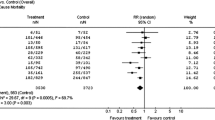Abstract
The majority of patients with implantable cardioverter defibrillator (ICD) devices receive antiarrhythmic drugs [1]. A major advantage of using drugs in an ancillary role is that less toxic drugs and lower drug doses can be utilized. The rationale for concominant antiarrhythmic drug therapy includes:
-
1)
suppression of frequent sustained and unsustained ventricular tachycardia,
-
2)
suppression of supraventricular tachycardia,
-
3)
slowing the maximal sinus rate to below the ventricular tachycardia rate, and
-
4)
slowing the rate of ventricular tachycardia to avoid syncope prior to device discharge.
Access this chapter
Tax calculation will be finalised at checkout
Purchases are for personal use only
Preview
Unable to display preview. Download preview PDF.
Similar content being viewed by others
References
Echt DS, Armstrong K, Caltagerone P, Oyer PE, Stinson EB, Winkle RA (1985) Clinical experience, complications and survival in 70 patients with the automatic implantable cardioverter/defibrillator. Circulation 71: 291–296
Echt DS, Black JB, Barbey JT, Coxe DR, Cato E (1989) Evaluation of antiar¬rhythmic drugs on defibrillation energy requirements in dogs: sodium chan¬nel block and action potential prolongation. Circulation 79: 1106–1117
Echt DS, Cato EL, Coxe DR (1989) pH-dependent effects of lidocaine on defibrillation energy requirements in dogs. Circulation 80: 1003–1009
Schräder R, Brooks M, Echt DS (1990) Verapamil increases the internal defibrillation energy requirements in anesthetized dogs. A Am Coll Cardiol 15:73 A
Babbs CF, Yim GKW, Whistler SJ, Ikcker WA, Geddes LA (1979) Elevation of ventricular defibrillation threshold in dogs by antiarrhythmic drugs. Am Heart J 98 (3): 345–350
Fain ES, Dorian P, Davy JM, Kates RE, Winkle RA (1986) Effects of en- eainide and its metabolites on energy requirements for defibrillation. Circula¬tion 73 (6): 1334–1341
Hernandez R, Mann DE, Breckinridge S, Williams GR, Reiter MJ (1989) Effects of flecainide on defibrillation thresholds in the anesthetized dog. J Am Coll Cardiol 14 (3): 777–781
Frame LH, Sheldon JH (1988) Effect of recainam on the energy required for ventricular defibrillation in dogs as assessed with implanted electrodes. J Am Coll Cardiol 12 (3): 746–752
Ruffy R, Schechtman K, Monje E (1985) Adrenergic modulation of direct defibrillation energy in anesthetized dog heart. Am J Physiol 248: H 674–H 677
Wang M, Dorian P (1989) DL and D Sotalol decrease defibrillation energy requirements. PACE 12: 1522–1529
Tacker WA, Niebauer MJ, Babbs CF, Combs WJ, Hahn BM, Barker MA, Siepel JF, Bourland JD, Geddes LA (1980) The effect of newer antiarrhythmic drugs on defibrillation threshold. Crit Care Med 8 (3): 177–180
Dorian P, Fain ES, Davy JM, Winkle RA (1986) Effect of quinidine and bretylium on defibrillation energy requirements. Am Heart J 112 (1): 19–25
Woolfolk DI, Chaffee WR, Cohen W, Neville JF, Abildskov JA (1966) The effect of quinidine on electrical energy required for ventricular defibrillation. Am Heart J 72 (5): 659–663
Frame LH (1989) The effect of chronic oral and acute intravenous amiodar- one administration on ventricular defibrillation threshold using implanted electrodes in dogs. PACE 12: 339–346
Fain ES, Lee JT, Winkle RA (1987) Effects of acute intravenous and chronic oral amiodarone on defibrillation energy requirements. Am Heart J 114: 8–17
Fogoros RN (1984) Amiodarone-induced refractoriness to cardioversion. Ann Intern Med 100 (5): 699–700
Winkle RA, Mason JW, Griffin JC, Ross D (1981) Malignant ventricular tachyarrhythmias associated with the use of encainide. Am Heart J 102 (5): 857–864
Marinchak RA, Friehling TD, Kline RA, Stohler J, Kowey PR (1988) Effect of antiarrhythmic drugs on defibrillation threshold: case report of an adverse effect of mexiletine and review of the literature. PACE 11: 7–12
Echt DS, Lee JT, Roden DM, Crawford DM, Horrell KD, Frist WH, Hammon JW (1989) Effects of lidocaine on defibrillation energy requirements in patients. Circulation 80: 11–224
Lang DJ, Cato DL, Echt DS (1989) Protocol for evaluation of internal defribrillation safety margins. J Am Coll Cardiol 13:111 A
Guarnieri T, Datorre SD, Bondke H, Brinker J, Myers S, Levine JH (1988) Increased pacing threshold after an automatic defibrillator shock in dogs: effects of Class I and Class II antiarrhythmic drugs. PACE 11: 1324–1330
Ciccone JM, Saksena S, Shah Y, Pantopoulos D (1985) A prospective ran¬domized study of the clinical efficacy and safety of transvenous cardioversion for termination of ventricular tachycardia. Circulation 71 (3): 571–578
Naccarelli GV, Zipes DP, Rahilly GT, Heger JJ, Prystowsky EN (1983) Influence of tachycardia cycle length and antiarrhythmic drugs on pacing termination and acceleration of ventricular tachycardia. Am Heart J 105(l):l–5
Editor information
Editors and Affiliations
Rights and permissions
Copyright information
© 1992 Springer-Verlag Berlin Heidelberg
About this paper
Cite this paper
Echt, D.S. (1992). Combining Drugs with the Implantable Cardioverter Defibrillator: Clinical Implications. In: Alt, E., Klein, H., Griffin, J.C. (eds) The Implantable Cardioverter/Defibrillator. Springer, Berlin, Heidelberg. https://doi.org/10.1007/978-3-642-76575-9_12
Download citation
DOI: https://doi.org/10.1007/978-3-642-76575-9_12
Publisher Name: Springer, Berlin, Heidelberg
Print ISBN: 978-3-642-76577-3
Online ISBN: 978-3-642-76575-9
eBook Packages: Springer Book Archive




